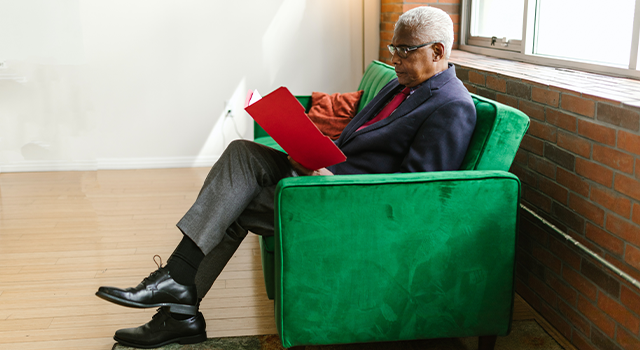
Most people experience some degree of vision loss as they age. But if your eye problems have made basic daily tasks difficult or impossible to do—and no glasses, contacts, surgery or medication can help—then you probably have low vision.
Adapting to vision loss can be difficult and may lead to sadness, frustration, a sense of isolation and helplessness. Millions of people around the world have gone through these same frustrations and anxieties, and we at are here to let you know that there are several ways to cope with low vision. These include adopting new strategies and choosing from a variety of glasses, aids and devices.
But First, What is Low Vision?
If you have low vision, it means that your level of vision is preventing you from doing the tasks you need or want to do, and vision cannot be fixed with contacts, glasses or surgery. Low vision can make it difficult to do everyday tasks, such as reading menus or other texts, using a computer, watching TV, driving, and even cooking.
Common eye diseases that cause low vision include glaucoma, macular degeneration, retinitis pigmentosa, and diabetic retinopathy. Moreover, brain injury caused by stroke, trauma, or a tumor can result in a loss of sight in your visual field.
As mentioned above, there are many ways to manage low vision, including using special lenses, glasses and devices. Your low vision [eye_ doctor] can prescribe low vision glasses and devices that can make a dramatic difference in your life and make it easier for you to do the things you love.
Examples of Optical and Non-Optical Aids
Thanks to modern technology, people with low vision can now do things that were once impossible for them—like reading a book, using a computer, and even, in some cases, driving!
(Keep in mind that some of these devices can be hand-held, spectacle or stationary).
-
- Microscope glasses
- Telescopic glasses
- Prism glasses
- Magnifying glasses
- Hand magnifiers
- Closed-circuit television (CCTV)
- Lenses that filter light
- Reading prisms
- Electronic glasses
- Eyeglasses with special lenses
Desktop CCTV systems can be a great way to help you zoom in on things you may not be able to see clearly on your screen. This can be really helpful when it comes to looking at photos and text, especially if you have a hard time seeing smaller details.
Certain non-optical aids are extremely useful in helping you partake in daily activities.
For example, screen readers can also be really great for people who are visually impaired, as they can read web pages back to the user in a clear and concise manner.
Furthermore, certain mobile apps use audio, visual, GPS and computing capabilities. And if you're struggling to read print material, there are text-to-voice translation systems that can read aloud for you.
Whether you have AMD, glaucoma, diabetic retinopathy, or any other eye disease (or incident) that has resulted in low vision, we offer a low vision technology that can help you live more fully and independently.
Looking for a Low Vision Eye Doctor in ?
Every person with low vision has unique needs, so deciding which low vision aids and devices to use is an individual choice that you and your low vision optometrist will make together.
Your low vision eye doctor will evaluate your vision and eye health, and discuss exactly how vision loss is affecting your day-to-day life and activities. Based on your degree of vision loss and lifestyle, your low vision eye doctor will prescribe low vision aids and devices that will help you read, work at your computer, watch TV, navigate at home and outdoors and so much more.
Contact in to find out which of the latest low vision glasses, aids and devices may help you regain the independence that you seek.
Our practice serves patients from Test city, Test City2, Test City3, and Test City4, Test State and surrounding communities.
Frequently Asked Questions With Test Sandeep
A: Low vision is a condition where a person's eyesight is impaired to the point where they are unable to do everyday tasks, like reading or driving. Some common causes of low vision include age-related macular degeneration (AMD), glaucoma retinal detachment and diabetic retinopathy. Low vision may also result from eye cancer, brain injury, stroke, or inherited conditions, such as retinitis pigmentosa.
Q: What are the most common types of low vision?
A: The most common types of low vision are: central vision loss, peripheral vision loss, night blindness and blurry or hazy vision.
- Central vision loss is the inability to see things in the center of your vision.
- Peripheral vision loss is the inability to see things out of the corners of your eyes.
- Night blindness is the inability to see in low light.
- Blurry or hazy vision is when your vision is not as clear as it used to be.
If you experience any of these, it’s important to see a low vision eye doctor who will prescribe the best vision aids, devices and glasses for your visual needs.



